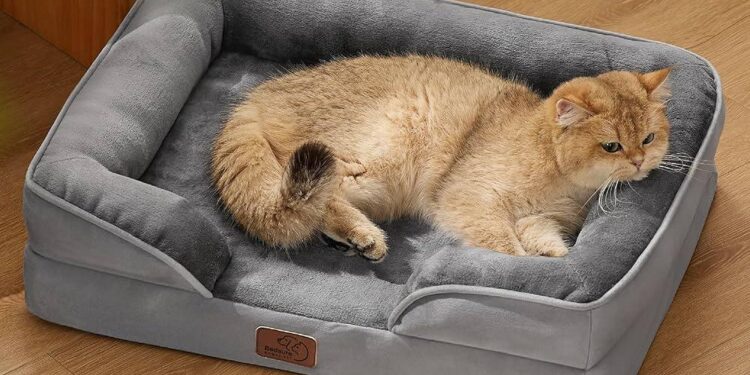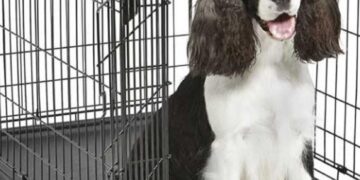Table of Contents
The Night the Bars Bent and My Beliefs Broke
For years, I’ve worked with large-breed dogs—powerful, intelligent animals that demand an equally thoughtful approach to their care.
I considered myself knowledgeable, a practitioner who had seen it all.
I had a beautiful, brilliant rescue, a shepherd mix with a mind like a diamond and anxiety to match.
I did everything by the book.
I bought the highest-rated “heavy-duty” wire crate on the market, the kind recommended by countless trainers and websites.1
I spent weeks on positive reinforcement, making the crate a palace of high-value treats and comfort.
And for a while, it worked.
Then came the night that shattered my confidence.
I returned home late to a scene of quiet chaos.
The steel bars of the crate were twisted into grotesque, unnatural angles.
The latch was still closed, but a gap had been forced wide enough for a desperate body to squeeze through.
On the floor, I found a bloody paw print.
My dog, my trusted companion, greeted me not with a wagging tail but with a bloody mouth, a broken tooth, and a look of sheer, exhausted panic.3
The room was a wreck, but the damage to my dog and our trust was far worse.
Shaken, I assumed it was a product failure.
So I did what any responsible owner would do: I escalated.
I bought an even more expensive, even “stronger” wire crate, one with thicker gauge steel.
The result was the same, only this time he managed to bend the door frame itself, getting his head stuck in the process.
It was a terrifying, heartbreaking failure.3
I realized then that my entire approach was wrong.
I wasn’t just failing to contain my dog; I was failing to understand the fundamental nature of the problem.
Simply adding thicker wire to a flawed design was like trying to make a tent burglar-proof by using thicker canvas.
The architecture itself was broken.
The epiphany arrived from a completely unexpected place.
For a work project, I was researching high-security building design, delving into principles like “Security by Design” and “Crime Prevention Through Environmental Design (CPTED)”.5
I read about layered security, monolithic construction, and the critical importance of access control points.
A lightbulb went off with blinding intensity.
A dog kennel isn’t a cage.
It isn’t a temporary box.
For a dog, especially a large or anxious one, it is their most personal space—their home, their bedroom, their safe room.
A kennel is a piece of architecture.
And I had been giving my dog the equivalent of a house made of glass.
This realization didn’t just give me a new product to buy; it gave me a completely new paradigm for how to choose one.
The Paradigm Shift: A Kennel Is Architecture, Not a Cage
We don’t secure a bank vault by simply making the walls thicker while leaving a flimsy wooden door.
We design it as a holistic system: reinforced single-piece construction, advanced multi-point locking mechanisms, and controlled ventilation.5
It is an engineered environment designed to be impregnable.
A dog’s kennel, their most intimate and vulnerable space, deserves the same level of thoughtful design.
When we shift our thinking from “buying a cage” to “specifying a piece of secure personal architecture,” the criteria for what makes a kennel “good” changes dramatically.
This “Secure Canine Architecture” model is built on three foundational pillars, drawn directly from the principles of secure design and environmental psychology.6
These pillars provide a robust framework for evaluating any kennel and will form the structure of this guide:
- Structural Integrity & Material Science (The Walls & Foundation): This pillar examines the core materials and construction methods. It asks: Is the structure fundamentally sound? Can it withstand the forces applied to it without catastrophic failure?
- Access Control & Escape Prevention (The Doors & Vents): This pillar focuses on every potential point of entry or exit. It asks: Are the doors, latches, and ventilation holes as secure as the walls themselves? A structure is only as strong as its weakest point.
- Environmental Design & Psychological Well-being (The Interior & Atmosphere): This pillar addresses the occupant’s experience inside the space. It asks: Does the design create a sense of safety and calm, or does it induce stress and panic? This is about the psychology of the space.
This architectural approach aligns perfectly with a dog’s innate psychology.
The concept of a “den” is often invoked in crate training, but the advice is frequently superficial.9
A den’s value isn’t just that it’s an enclosed space; its true psychological benefit comes from the deep-seated feeling of security.
A true den is impenetrable from the outside and secure from within.
A flimsy structure that can be bent, broken, or escaped from is not a den; it’s a trap.
It’s only when the architectural integrity is so absolute that the dog no longer perceives escape as necessary or even possible that the kennel can transform from a source of anxiety into a true sanctuary.12
The engineering creates the psychology.
Pillar I: Structural Integrity & Material Science (The Walls & Foundation)
The foundation of any secure structure is its core construction.
In the world of dog kennels, there is a vast difference between designs that merely suggest containment and those engineered for absolute structural integrity.
Evaluating the “walls and foundation” of a kennel requires looking past marketing terms like “heavy-duty” and analyzing the material science and construction methods.
Deconstructing Flawed Architectures
Before building up, we must first tear down the common but critically flawed designs that dominate the market.
- The Glass House (Wire Crates): Wire crates are the most common and, for a powerful or anxious dog, the most dangerous option. Their architecture is fundamentally compromised. The entire structure is a collection of failure points: the welds connecting the wires can snap, and the thin metal bars themselves can be bent or broken by a determined dog’s teeth or paws.3 This creates gaps for escape and poses a horrifying risk of injury, including broken teeth, lacerated gums, and even strangulation.14 Watching a dog force its way out of a wire crate is a terrifying sight, as the flexible panels can trap them mid-escape.4 Popular brands like MidWest Life Stages, while suitable for calm, fully trained dogs, represent this structurally deficient category.1 They provide the illusion of a boundary without the reality of security.
- The Prefab Shed (Two-Piece Plastic Crates): Standard plastic travel kennels, like those from Petmate, are a step up in terms of creating an enclosed, den-like feel.1 However, their two-piece construction is their Achilles’ heel. The top and bottom halves are typically joined by plastic bolts or clips along a seam—a clear and significant structural weakness that a strong dog can exploit.16 Furthermore, the plastic itself, while stronger than a wire grid, can be gnawed and destroyed by a persistent chewer, especially around the door or ventilation windows.15 They are better than wire, but they are not an architectural solution for a serious containment challenge.
Exploring Sound Architectures
True security begins with construction methods that eliminate inherent weaknesses.
Two primary architectural forms stand out in the premium kennel market.
- The Monolithic Dome (Roto-Molded Plastic Kennels): This represents a revolutionary leap in kennel design. Rotational molding, or “roto-molding,” is a manufacturing process that creates a single, seamless piece of plastic.18 By molding the kennel as a unibody shell, this process eliminates the vulnerable seams and joints found in two-piece crates. Brands like RuffLand Kennels and Gunner Kennels are the leaders in this space.
The material science here is also more sophisticated. RuffLand, for instance, engineers its UV-stabilized polyethylene with Ruff-Flex™ Energy Dissipation Technology. This means the walls have built-in flexibility designed to absorb impact in a collision, dissipating energy that would otherwise be transferred directly to the dog.19 This is a crucial, counter-intuitive insight: in some scenarios, flexibility equals safety.
Gunner takes a different approach to the same material, using a double-wall roto-molded construction. This creates an air buffer between two thick layers of plastic, providing twice the impact protection in a crash and superior insulation, keeping the dog cooler in the heat and warmer in the cold.21 This double-wall design prioritizes rigidity and force resistance, creating an incredibly robust structure. - The Fortified Safe Room (High-Grade Aluminum Kennels): For the most extreme cases—the true escape artists and dogs with severe containment anxiety—welded aluminum kennels are the pinnacle of structural integrity. Brands like Impact Dog Crates utilize high-grade aluminum, a material known for its high strength-to-weight ratio, and construct their kennels with welded seams and reinforced corners.23 This is not simply a box made of metal; it is an engineered containment system, often inspired by military and law enforcement K9 transport standards.24 The design philosophy is to create a structure so fundamentally sound that it is, for all intents and purposes, indestructible from the inside. This level of structural integrity is what can finally give peace of mind to owners who have experienced repeated failures with lesser designs.
The choice between a flexible single-wall roto-molded design and a rigid double-wall or aluminum design is not a simple matter of “good vs. bad.” It represents two distinct and valid engineering philosophies.
RuffLand’s lighter, flexible design prioritizes energy absorption and portability, making it an excellent all-around choice.
Gunner’s heavier, more rigid double-wall design is hyper-focused on maximizing survivability in a high-impact vehicle collision.
Impact’s aluminum construction is geared toward defeating escape attempts driven by extreme anxiety.
Understanding these different design intents is key to selecting the right architecture for your dog’s specific needs.
| Table 1: Architectural Material Analysis | |||||
| Material/Construction Type | Key Brands | Structural Principle | Impact Resistance | Chew/Escape Resistance | Estimated Cost |
| Wire Crate | MidWest, Frisco | Interlocking Panels | Low | Very Low | $ – $$ |
| Two-Piece Plastic | Petmate, Aspen Pet | Bolted Halves | Low-Medium | Low | $ – $$ |
| Roto-Molded Plastic (Single-Wall) | RuffLand Kennels | Unibody Shell (Flexible) | High | High | $$$ |
| Roto-Molded Plastic (Double-Wall) | Gunner Kennels | Unibody Shell (Rigid) | Very High | Very High | $$$$ |
| Welded Aluminum | Impact Dog Crates | Reinforced Monocoque | Very High | Extreme | $$$$$ |
Pillar II: Access Control & Escape Prevention (The Doors & Vents)
An architectural axiom states that a building is only as secure as its weakest point of access.6
For a dog kennel, these points are the door and any ventilation openings.
A determined dog will ignore the solid walls and focus all its energy on these perceived vulnerabilities.
Therefore, the design of these “fenestrations” is not an afterthought; it is as critical as the foundation itself.
Door & Latch System Analysis
The door is the primary target for any escape attempt.
Its construction and, most importantly, its latching mechanism, determine whether it is a secure portal or a point of catastrophic failure.
- The Screen Door (Slide-Bolts): The simple slide-bolt latches found on virtually all wire crates are a fundamental design flaw for any dog with a modicum of strength or intelligence. These latches can be jiggled loose, bent by force, or manipulated by a paw or snout.4 Many escape stories begin with a dog simply pushing on the door until the flimsy latch gives way. This system offers the bare minimum of closure, not security.
- The Composite Door (Roto-Molded Kennels): A significant upgrade is seen in brands like RuffLand, which use a strong, solid composite door. This immediately eliminates the weakness of a wire grid door. Crucially, their design features a “no-bite grid pattern” to deter chewing and multiple locking lugs that secure the door firmly in the frame.25 The door is also often ambidextrous, able to be configured to swing open in either direction, adding a layer of user convenience without compromising security.16
- The Vault Door (High-Security Kennels): The pinnacle of access control is found in the high-security kennels. Gunner’s G1 Kennel features a robust paddle-latch that is easy for a human to operate but difficult for a dog to manipulate, and it includes a key lock for absolute security. It is further reinforced with top and bottom backup safety latches, creating a multi-point locking system.21 Impact Dog Crates employs powerful butterfly latches (on its High Anxiety model) or slam latches that are completely inaccessible from inside the crate. These can be secured with a padlock or carabiner for an additional layer of redundant security.23 These are not just latches; they are engineered locking systems designed to defeat both brute force and clever manipulation.
Ventilation as a Controlled Opening
Ventilation is essential for a dog’s health and comfort, preventing overheating and ensuring fresh air.9
However, every hole is a potential vulnerability.
The evolution of vent design is a perfect illustration of the shift from a simple housing mindset to a secure architecture paradigm.
Standard plastic crates often feature large, window-like slatted openings.15
While providing ample airflow, these openings present a perfect edge for a chewing dog to get started and can be a point of weakness.
In contrast, high-security designs treat vents as controlled apertures.
The Impact High Anxiety Crate, for example, features rows of smaller, circular holes.
These holes are large enough for excellent airflow but are specifically sized and shaped to prevent a dog from getting its jaw or even a single tooth around the edge to start chewing.24
This is a direct engineering solution to a known behavioral failure point.
RuffLand Kennels incorporates a clever environmental design feature called the
Surevent™ Tapered Wall.
The kennel walls are tapered, so even if the crate is pushed flush against a wall or another object, the vent holes cannot be completely blocked, ensuring the dog always has airflow.20
This meticulous attention to the design of openings reveals the core of the architectural mindset.
It’s not enough to have a door; you need a vault door.
It’s not enough to have holes for air; you need vents that are secure against tampering.
Every element is considered through the lens of potential failure, and engineered to prevent it.
Pillar III: Environmental Design & Psychological Well-being (The Interior)
A truly secure space is not just one that is physically impregnable, but one that fosters a sense of psychological safety in its occupant.8
For a dog, this means the kennel’s interior environment must be predictable, comfortable, and free from stressors.
The goal of superior architectural design is to create a space so inherently secure and calming that the dog no longer feels the compulsion to test its boundaries.
The physical security becomes the foundation upon which psychological well-being is built.
Key Interior Design Features
The internal environment of the kennel has a profound impact on the dog’s experience.
Several key features contribute to creating a positive, low-stress interior.
- Flooring and Cleanliness: Comfort underfoot and a clean environment are paramount. Hard, slick surfaces can be uncomfortable and potentially harmful to a dog’s joints, while porous materials can harbor bacteria and odors.9 High-end kennels address this with thoughtful floor design. Both RuffLand and Gunner feature raised floors that channel liquids like spilled water or urine away from the dog, keeping them clean and dry.19 This simple feature significantly enhances comfort and hygiene. The seamless, unibody construction of roto-molded and aluminum crates makes them exceptionally easy to clean. There are no cracks or crevices for grime to accumulate, and they can be hosed out completely.31 Gunner kennels even include a drain plug to facilitate easy cleaning, a feature that underscores a commitment to a healthy interior environment.21
- Visibility vs. Enclosure: This represents a critical design trade-off that directly impacts a dog’s psychology. The open grid of a wire crate provides maximum visibility and airflow but can lead to sensory overload and anxiety for some dogs, as they are constantly exposed to household activity.15 Conversely, the enclosed sides of a plastic or aluminum kennel create a more private, den-like atmosphere that many anxious dogs find calming.9 This reduced visibility helps them disengage and relax. However, for a highly social dog, it could feel isolating. The ideal design provides a balance: enough enclosure to feel secure, with enough ventilation to feel connected and comfortable.
- The Sizing Fallacy: The standard advice for sizing a crate is that the dog should be able to stand up, turn around, and lie down comfortably.28 While this is a necessary minimum, it is an insufficient and often misleading rule. The optimal size is highly context-dependent. A crate that is too large for daily home use can encourage a dog to urinate in one corner and sleep in another, undermining house-training efforts.28 For vehicle travel, a snugger fit is significantly safer, as it minimizes the distance a dog can be thrown inside the kennel during a collision, reducing the force of a secondary impact.14 For a highly anxious dog, a slightly smaller, more womb-like space can feel more secure than a cavernous one. The “right size” is not a single measurement but a strategic choice based on the kennel’s primary purpose and the dog’s specific temperament.
The Critical Warning: A Secure Crate is Not a Cure
It is irresponsible to discuss “indestructible” crates without issuing a serious warning.
A high-security kennel is a powerful management tool, but it is not a cure for separation anxiety or other behavioral issues.27
If a dog’s underlying panic is not addressed through training and, if necessary, veterinary consultation, placing it in a truly escape-proof crate can have devastating consequences.
A dog in a full-blown panic attack may injure itself, breaking teeth or claws in a frantic attempt to escape an unyielding prison.3
In the worst cases, this can lead to a state of “learned helplessness,” where the dog emotionally shuts down after realizing its desperate efforts are futile.35
A secure kennel works best when it is part of a holistic plan to build a dog’s confidence.
Its purpose is to prevent self-harm and property destruction while behavior modification is underway.
The ultimate success of a well-designed kennel is measured not by its ability to contain a frantic dog, but by its ability to create such a profound sense of security that the dog no longer becomes frantic in the first place.
Many owners of premium crates report that after an initial testing period, their anxious dogs begin to seek out the crate voluntarily as a place of rest and calm.25
This is the true goal of secure canine architecture.
The Architect’s Choice: Matching the Design to the Occupant
With a solid understanding of the three architectural pillars, we can now move from theory to practice.
As a consulting architect, the final step is to match the right “building” to the specific “client.” There is no single “best” kennel for every large dog.
The optimal choice depends entirely on the dog’s individual profile and the primary security threats you need to mitigate.
Canine Client Profiles & Architectural Solutions
Here are four common profiles of large dogs and the architectural solutions best suited to their needs.
- Profile 1: The Anxious Escape Artist
- Description: This dog suffers from containment or separation anxiety, leading to persistent and destructive escape attempts. They have likely defeated wire or standard plastic crates and may have injured themselves in the process.
- Primary Need: Absolute, guaranteed containment to prevent escape and self-harm.
- Top Architectural Principle: Structural Integrity and Access Control. The focus must be on an indestructible shell and an infallible locking system.
- Recommended Model: Impact High Anxiety Crate. This kennel is the architectural equivalent of a fortified safe room. Its welded aluminum construction, escape-proof butterfly latches, and small, non-chewable vent holes are specifically engineered to defeat the behaviors of this profile. The company’s Lifetime Dog Damage Guarantee is a testament to their confidence in the design, offering a crucial promise to owners at their wits’ end.24
- Profile 2: The Globetrotting Athlete (Frequent Vehicle Travel)
- Description: This dog is a constant companion on the road, whether for work (K9 units), dog sports, or family adventures. They spend a significant amount of time traveling in a vehicle.
- Primary Need: Supreme crash protection. The primary threat model is a high-impact vehicle collision.
- Top Architectural Principle: Impact Resistance and Energy Dissipation.
- Recommended Model: Gunner G1 Kennel. This is the armored personnel carrier of dog kennels. Its 5-star crash-test rating from the Center for Pet Safety is its most compelling feature.21 The double-wall roto-molded construction, robust door system, and integrated stainless-steel tie-down pins are all designed with one goal in mind: maximizing the dog’s survivability in a wreck. For owners whose top priority is safety on the road, the Gunner is the clear choice.37
- Profile 3: The Weekend Warrior (General & Versatile Use)
- Description: This dog is active and goes places, but doesn’t live on the road. The owner needs a kennel that is safe for car trips but also light enough to move between the car and the house, or to take to a hotel or dog-sport event.
- Primary Need: A balance of safety, portability, and versatility.
- Top Architectural Principle: A blend of Structural Integrity and thoughtful Environmental Design.
- Recommended Model: RuffLand Kennels. RuffLand offers the perfect compromise. Its single-piece roto-molded construction provides excellent safety and durability—far superior to standard crates—but it remains significantly lighter than a Gunner or Impact crate.16 Clever features like the stackable design, tapered vent walls, and multiple door configuration options make it incredibly versatile for a wide range of uses. It is the performance pod for the dog and owner on the go.20
- Profile 4: The Well-Mannered Homebody
- Description: This dog is calm, non-destructive, and fully crate trained. They do not have escape tendencies or severe anxiety. The kennel is primarily for home use, providing a comfortable den.
- Primary Need: Comfort, aesthetics, and basic, reliable containment.
- Top Architectural Principle: Environmental Design & Psychological Well-being.
- Recommended Models: Furniture-Style Crates (Fable, Diggs Revol) or RuffLand Kennels. For a dog that presents no major security challenges, aesthetics and integration with home decor can become a higher priority.1 Brands like Fable offer stylish wooden designs. The Diggs Revol is a standout in this category, offering a significant safety and usability upgrade over wire crates (e.g., safer mesh, easier collapsing) in a modern, attractive package.37 A RuffLand kennel is also an excellent choice here, providing top-tier safety in a clean, functional design that still looks good in a home.
| Table 2: The Architect’s Spec Sheet – Matching Kennel to Canine Profile | ||||
| Canine Profile | Primary Need | Top Architectural Principle | Recommended Model(s) | Key Justification |
| The Anxious Escape Artist | Maximum Containment | Structural Integrity | Impact High Anxiety Crate | Welded aluminum, escape-proof latches, dog damage guarantee.24 |
| The Globetrotting Athlete | Crash Protection | Impact Resistance | Gunner G1 Kennel | 5-star crash-tested, double-wall construction, secure tie-downs.21 |
| The Weekend Warrior | Versatility & Portability | Balanced Design | RuffLand Kennels | Roto-molded strength, lighter weight, stackable, versatile features.16 |
| The Well-Mannered Homebody | Comfort & Aesthetics | Environmental Design | Fable, Diggs Revol, RuffLand | Blends with decor while providing safe, reliable containment for a calm dog.37 |
Conclusion: Building a Foundation of Trust
After the second wire crate failed, I threw out the old rulebook and embraced the principles of Secure Canine Architecture.
My dog was a classic “Anxious Escape Artist.” His primary need was absolute containment to keep him safe from himself.
The choice became clear.
I invested in an Impact High Anxiety Crate.
The first few times I left him, I watched on a camera, my heart pounding.
He paced.
He pushed at the door.
He tested the walls.
But the architecture held.
The solid aluminum didn’t bend.
The butterfly latches didn’t budge.
The small vent holes gave him no purchase for his teeth.
For the first time, the kennel’s boundaries were absolute and non-negotiable.
After about twenty minutes of fruitless testing, something remarkable happened.
He lay down.
He let out a deep sigh.
And he went to sleep.
In the weeks that followed, the testing behavior diminished until it vanished completely.
The panic was replaced by calm.
Today, he no longer waits for a command.
When a thunderstorm rolls in or the house gets too chaotic, he goes into his kennel on his own.
He seeks it O.T. It has become his sanctuary, his den, his safe room.
The architecture worked.
It provided such profound physical security that it created profound psychological safety.
Choosing the right kennel is one of the most significant acts of care we can perform for our large dogs.
It is a decision that extends far beyond simple convenience or containment.
By thinking like an architect—by prioritizing structural integrity, access control, and the psychological impact of the environment—we can move beyond the flawed paradigm of cages and boxes.
We can provide our companions with a space that is not about restriction, but about security.
We can build them a foundation of safety and, in doing so, build an even deeper foundation of trust.
Works cited
- The 12 Best Big Dog Crates for Large and Giant Breeds – Rover.com, accessed August 14, 2025, https://www.rover.com/blog/reviews/large-dog-crates/
- The 14 Best Heavy-Duty Dog Crates for Escape Artists and Chewers – Rover.com, accessed August 14, 2025, https://www.rover.com/blog/best-heavy-duty-dog-crates-for-2020/
- Trying to find indestructible dog crate : r/Dogtraining – Reddit, accessed August 14, 2025, https://www.reddit.com/r/Dogtraining/comments/103akex/trying_to_find_indestructible_dog_crate/
- Escape from Crate : r/fosterdogs – Reddit, accessed August 14, 2025, https://www.reddit.com/r/fosterdogs/comments/1glztyb/escape_from_crate/
- Designing Secure Spaces – Number Analytics, accessed August 14, 2025, https://www.numberanalytics.com/blog/ultimate-guide-security-surveillance-architectural-design
- Improving Security by Design in Architecture with Security Glazing – Riot Glass, accessed August 14, 2025, https://www.riotglass.com/security-by-design/
- How Architects Approach Safety in Design, accessed August 14, 2025, https://halajianarch.com/safety-in-architecture/
- How Leaders Can Build Psychological Safety at Work – Center for Creative Leadership, accessed August 14, 2025, https://www.ccl.org/articles/leading-effectively-articles/what-is-psychological-safety-at-work/
- A Guide to Selecting the Right Large Dog Kennel, accessed August 14, 2025, https://alpinedogco.ca/blogs/dog/a-guide-to-selecting-the-right-large-dog-kennel
- 5 Best Tips About Large Dog Kennels, accessed August 14, 2025, https://www.thedogkennelcollection.com/blog/large-dog-kennel-guide/
- Dog Crate Anxiety – Whole Dog Journal, accessed August 14, 2025, https://www.whole-dog-journal.com/training/crates/what-to-do-when-your-dog-hates-his-crate/
- faithbehavioralhealth.com, accessed August 14, 2025, https://faithbehavioralhealth.com/why-is-personal-space-important/#:~:text=Personal%20space%20holds%20significant%20psychological,a%20healthy%20sense%20of%20self.
- Why is Personal Space Important? Guide to Healthy Boundaries – Faith Behavioral Health, accessed August 14, 2025, https://faithbehavioralhealth.com/why-is-personal-space-important/
- Wire crate vs Plastic Kennel : r/OpenDogTraining – Reddit, accessed August 14, 2025, https://www.reddit.com/r/OpenDogTraining/comments/1fttg54/wire_crate_vs_plastic_kennel/
- Plastic vs. Metal Crates | Choosing the Best Dog Crate Material – Petmate, accessed August 14, 2025, https://www.petmate.com/blogs/petmate-academy/plastic-vs-metal-crates-which-one-is-right-for-your-pet
- Ruff Land Kennel (Gen 2) Review – Dog Gear Review, accessed August 14, 2025, https://doggearreview.com/review/rufflandcrate/
- How to Pick the Best Crate for Your Dog: Plastic vs. Wire Crates, accessed August 14, 2025, https://www.impactdogcrates.com/blogs/puppy-news/how-to-pick-the-best-crate-for-your-dog-plastic-vs-wire-crates
- Large Dog Kennel – RuffLand, accessed August 14, 2025, https://www.rufflandkennels.com/products/large-kennel
- X-Large Kennel – RuffLand® Performance Kennels, accessed August 14, 2025, https://www.rufflandkennels.com/products/x-large-kennel
- RuffLand® Performance Kennels, accessed August 14, 2025, https://www.rufflandkennels.com/collections/kennels
- GUNNER Dog Crate | Crash Tested Travel | GUNNER Kennels, accessed August 14, 2025, https://gunner.com/products/g1-kennel
- Crash Tested Dog Crates | Heavy Duty K9 Travel Kennel – GUNNER, accessed August 14, 2025, https://gunner.com/collections/kennels
- Heavy Duty Collapsible Dog Crate – Large – K9 Kennel Boss, accessed August 14, 2025, https://k9kennelboss.com/products/k9-kennel-boss-large-heavy-duty-fully-collapsible-powder-coated-aluminum-dog-crate
- Impact Dog Crates: The Worlds Toughest Dog Crate, accessed August 14, 2025, https://www.impactdogcrates.com/
- Ruff Land Kennels X-Large Kennel, Double Door, Front and Left – US Patriot Tactical, accessed August 14, 2025, https://www.uspatriottactical.com/ruff-land-kennels-x-large-kennel-double-door-front-and-left
- Ruff Land Kennels XL Double Door Dog Kennel – Front Range Gun Dog, accessed August 14, 2025, https://www.frontrangegundog.com/product/ruff-tough-kennels-xl-double-door-dog-kennel/
- Impact High Anxiety Dog Crate Pros & Cons – Our Honest Review – Life With Klee Kai -, accessed August 14, 2025, https://lifewithkleekai.com/impact-high-anxiety-dog-crate-review/
- How to Choose the Best Crate for Your Dog, accessed August 14, 2025, https://www.akc.org/expert-advice/lifestyle/choose-best-crate-dog/
- All About Destructive Crate Behavior in Dogs – Impact Dog Crates, accessed August 14, 2025, https://www.impactdogcrates.com/blogs/puppy-news/all-about-destructive-crate-behavior-in-dogs
- Psychological Safe Space – LeaderFactor, accessed August 14, 2025, https://www.leaderfactor.com/learn/psychological-safe-space
- What to Look For in a Dog Kennel – Dakota 283, accessed August 14, 2025, https://dakota283.com/what-to-look-for-in-a-dog-kennel/
- The Complete Guide to Outdoor Dog Kennels for Large Dogs – Fisher Barns, accessed August 14, 2025, https://fisherbarns.com/blog/outdoor-dog-kennels-for-large-dogs/
- Destructive Crate Behavior: Causes & Prevention – Diggs Pet, accessed August 14, 2025, https://www.diggs.pet/blog/crate-training/crate-training/dog-chewing-on-crate/
- Will an Escape-Proof Crate Fix My Dog’s Separation Anxiety? – Journey Dog Training, accessed August 14, 2025, https://journeydogtraining.com/escape-proof-dog-crate/
- The “Escape-Proof” Dog Crate – A Canine Affinity, accessed August 14, 2025, https://www.acanineaffinity.com/blog/the-escape-proof-dog-crate
- Reviews – Impact Dog Crates, accessed August 14, 2025, https://www.impactdogcrates.com/pages/reviews
- The 6 Best Dog Crates, According To Pet Experts And Dog Owners – Forbes, accessed August 14, 2025, https://www.forbes.com/sites/forbes-personal-shopper/article/best-dog-crate/
- X-Large Dog Crates You’ll Love – Wayfair, accessed August 14, 2025, https://www.wayfair.com/pet/sb1/extra-large-95-lbs-and-up-dog-crates-c1824047-a8005~25172.html






